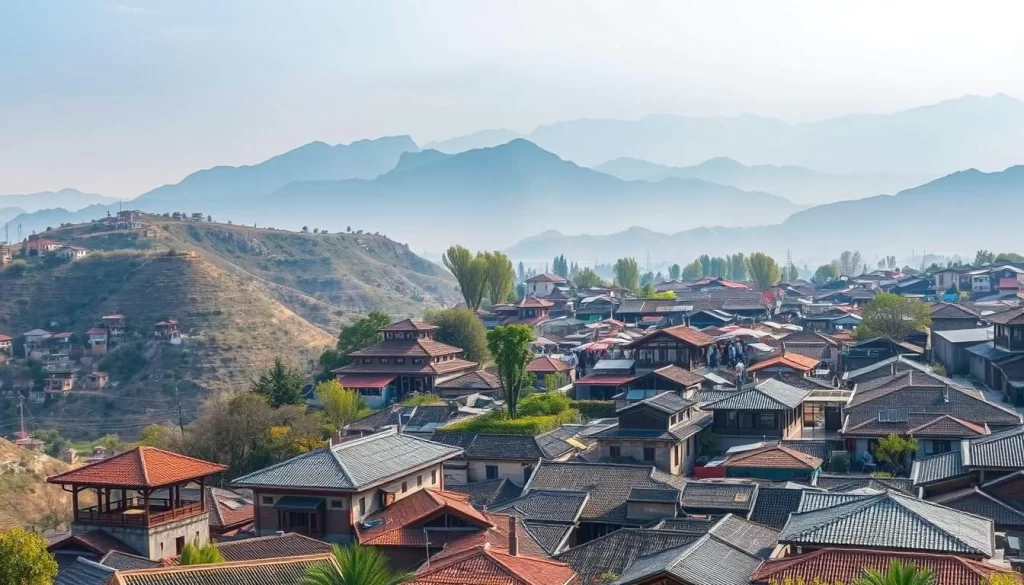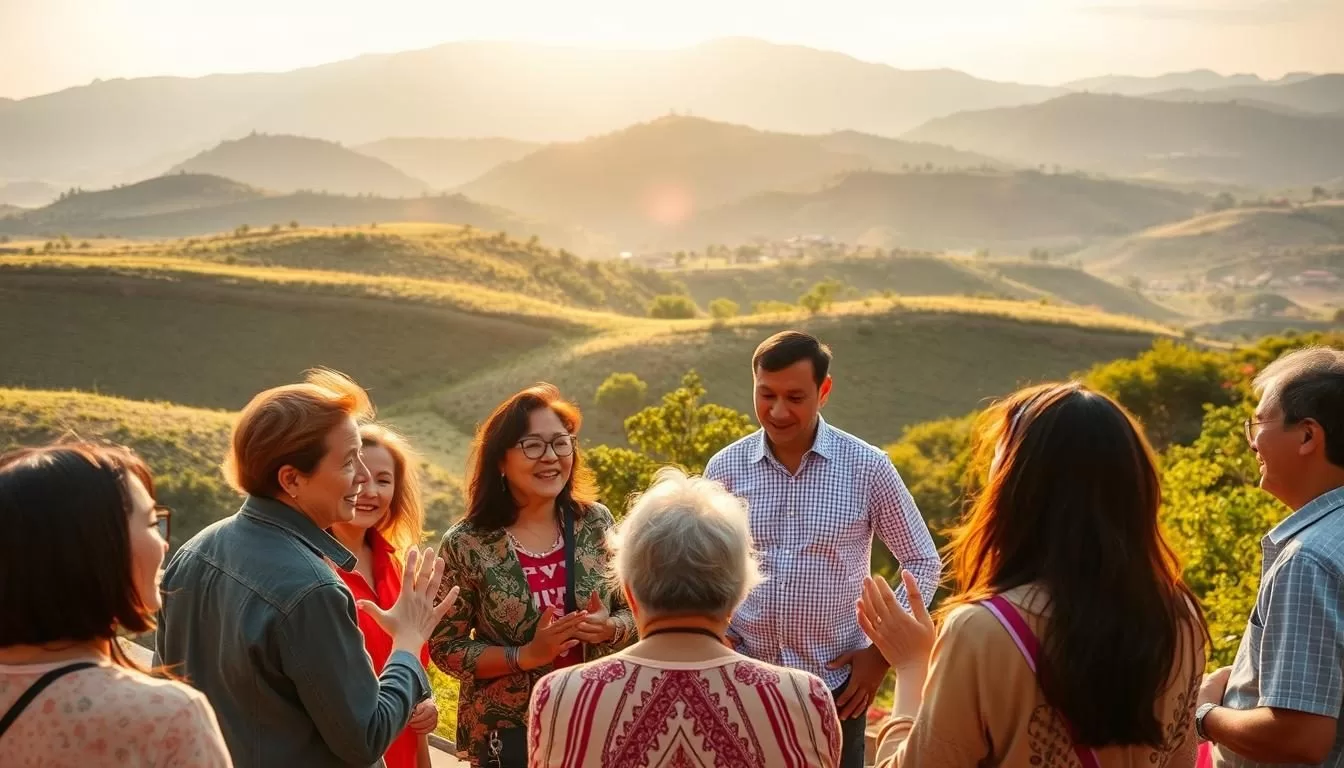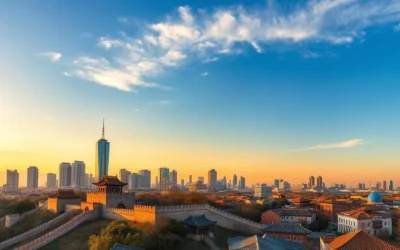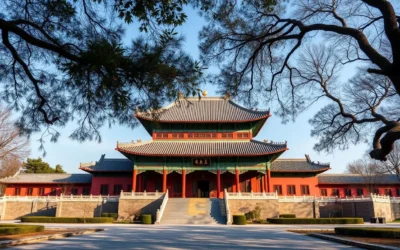✓ Accommodations✓ Flights✓ Rental Cars
When you explore the cultural richness of northern China, you’ll find a fascinating mix of languages and dialects. This region is home to a unique linguistic heritage that reflects its deep history and diverse population. Standard Mandarin serves as the official language, connecting people across the country. However, local dialects like Jin add a special flavor to daily communication.
The area’s linguistic identity is shaped by its history and ethnic groups. Writing systems and spoken forms have evolved over centuries, creating a vibrant tapestry of communication. Understanding these languages offers a glimpse into the lives of the people who call this place home.
With a population of 34,915,616, the region’s linguistic diversity is a testament to its cultural depth. Whether you’re interested in the Sino-Tibetan language family or the nuances of Mandarin Chinese, this area has much to explore.
Introduction to China’s Linguistic Diversity
China’s linguistic landscape is as vast and diverse as its geography. With over 302 living languages and dialects, the country is a treasure trove of spoken forms. This variety stems from its long history and expansive territory, where each region has developed its unique way of communication.

Mandarin, the official language, is spoken by over 900 million people, making it the most widely used form of communication. However, regional dialects like Cantonese, Wu, and Jin add layers of richness to the linguistic tapestry. These dialects are not just variations but distinct forms with their own tones, vocabulary, and cultural significance.
Understanding China’s Many Dialects
Dialects in China are more than just accents; they are deeply tied to local identity. For example, Cantonese, spoken by over 70 million people, is known for its nine distinct tones. Similarly, Jin Chinese, with 63 million speakers, reflects the cultural heritage of its region.
Here’s a quick look at some prominent dialects and their speaker counts:
| Dialect | Speakers (Millions) |
|---|---|
| Mandarin | 900 |
| Cantonese | 70 |
| Jin | 63 |
| Wu | 85 |
Historical and Cultural Influences
China’s linguistic diversity is deeply rooted in its history. Migrations, trade, and cultural exchanges have shaped the evolution of its languages. Traditional literature, opera, and local customs have also played a significant role in preserving these dialects.
“Language is the road map of a culture. It tells you where its people come from and where they are going.”
Efforts to standardize the written form, such as the introduction of Simplified Chinese characters in the 1950s, have helped improve literacy rates. Yet, the spoken forms continue to thrive, reflecting the country’s rich cultural heritage.
Shanxi Province, China: Official and widely spoken languages
In this northern region, the way people communicate reflects centuries of cultural evolution. Standard Mandarin serves as the official language, connecting people across the country. However, local dialects like Jin add a unique flavor to daily life.
Jin Chinese is a key marker of regional identity. Spoken by around 45 million people, it’s deeply tied to the area’s heritage. This dialect has evolved over time, shaped by migration and historical events. It’s a living testament to the region’s rich past.

Language policies here balance modernization with heritage preservation. Schools and media play a crucial role in promoting both Mandarin and local dialects. This approach ensures that the linguistic diversity of the region remains vibrant.
Here’s a quick look at the primary languages and their speakers:
| Language | Speakers (Millions) |
|---|---|
| Mandarin | 900 |
| Jin | 45 |
| Other Dialects | Varied |
The linguistic mix here is a result of centuries of cultural exchange. Migration and trade have brought new influences, enriching the local dialects. Traditional narratives and storytelling also play a role in keeping these languages alive.
Efforts to preserve this linguistic heritage are ongoing. Education systems teach both Mandarin and local dialects, ensuring that future generations remain connected to their roots. Media platforms also highlight the beauty of these languages, fostering pride among speakers.
As you explore this region, you’ll discover how language shapes its identity. From the tones of Jin to the clarity of Mandarin, every word tells a story. This blend of tradition and modernity makes the linguistic landscape here truly unique.
Cultural Heritage and Regional Identity in Shanxi
The blend of tradition and modernity in this region creates a unique cultural identity. Ancient practices, like shadow puppetry and local operas, continue to shape daily life. These traditions are not just relics of the past but living expressions of a proud heritage.
Modern development coexists with these age-old customs. Festivals and rituals bring communities together, reinforcing a sense of belonging. For example, the traditional ancestor worship ceremony has been preserved and adapted to contemporary life.

Tradition Meets Modernity
Efforts to preserve cultural heritage are evident in local initiatives. Community-driven projects ensure that traditional arts remain vibrant. Shadow puppet troupes, consisting of 5 to 6 people, perform at festivals and events, keeping this ancient art alive.
Education and media also play a role. Schools teach both modern skills and traditional practices, ensuring that younger generations stay connected to their roots. Media platforms highlight the beauty of these customs, fostering pride among speakers.
Here are some key cultural features passed down through generations:
- Shadow Puppetry: A centuries-old art form with roots in the Eastern Han dynasty.
- Local Operas: Performances that blend music, dance, and storytelling.
- Festivals: Celebrations that bring communities together.
Understanding these cultural dynamics is essential when exploring local language variations. The interplay of tradition and modernity shapes not just the culture but also the way people communicate. This blend makes the region’s identity truly unique.
Language Families and Dialect Variation in China
The linguistic diversity of this region is a reflection of its rich history and cultural depth. With over 302 living languages, the area is a treasure trove of spoken forms. This variety stems from centuries of migration, trade, and cultural exchange.

Sino-Tibetan Roots and Beyond
The Sino-Tibetan family is central to the linguistic landscape here. It includes over 400 languages spoken by approximately 1.4 billion people across Asia. Mandarin, a key member of this family, is spoken by 65.7% of the population.
Dialects like Jin and Cantonese add layers of richness to this mosaic. For example, Jin is spoken by 5.2% of the population, while Cantonese is used by 5.6%. These dialects are not just variations but distinct forms with their own tones and vocabulary.
Minority Languages and Their Unique Scripts
Minority languages like Tibetan, Uyghur, and Zhuang benefit from unique writing systems. These scripts differentiate them from the dominant logographic system used in Mandarin.
For instance, Tibetan uses a script derived from the ancient Brahmi system. Uyghur employs an Arabic-based script, reflecting its cultural ties. These scripts are not just tools for communication but symbols of cultural identity.
“Language is the roadmap of a culture. It tells you where its people come from and where they are going.”
Historical migrations and geographic isolation have fostered this diversity. Studying these language groups helps us understand the broader linguistic development of the region. This diversity also highlights the global significance of linguistic patterns.
Standard Mandarin and the Rise of Regional Dialects
Standard Mandarin bridges diverse communities across the country, serving as a unifying force in communication. Based on the Beijing dialect, it has been the national language since the early 20th century. Its widespread use connects people from different regions, fostering national unity.
Despite its dominance, regional dialects like Jin continue to thrive. These dialects are not just variations but distinct forms with their own tones and vocabulary. Efforts to preserve them are gaining momentum, ensuring they remain a vital part of local identity.
Mandarin’s Role in Uniting Diverse Communities
Mandarin’s role as the official language is crucial in a country with over 300 languages and dialects. It’s taught nationwide, enabling people from different backgrounds to communicate effectively. This standardization has improved literacy rates and economic opportunities.
However, the rise of Mandarin hasn’t erased regional dialects. Instead, it has created a balance between national unity and local cultural expression. Schools and media play a key role in promoting both, ensuring that dialects remain vibrant.
Revitalizing Local Dialects
In recent years, there’s been a renewed focus on preserving regional dialects. Cultural and academic institutions are leading the charge, documenting and teaching these spoken languages to younger generations. This effort ensures that dialects like Jin continue to be a part of daily life.
Government policies also support this revitalization. They encourage the use of dialects in media and education, fostering pride among speakers. This approach helps maintain the rich linguistic tapestry of the country.
Here’s a look at key dialects and their revitalization efforts:
| Dialect | Revitalization Initiatives |
|---|---|
| Jin | Documentation projects, local media programs |
| Cantonese | School curricula, cultural festivals |
| Wu | Academic research, community workshops |
Challenges remain, such as balancing modernization with heritage preservation. Yet, communities are finding innovative ways to keep their dialects alive. This blend of tradition and progress ensures that the language landscape remains dynamic and inclusive.
To learn more about the evolution of Mandarin, visit Standard Mandarin.
Government Language Policies and Their Impact
From 1912 to today, language reforms have transformed education and media. These policies aim to balance national unity with the preservation of local dialects. Over the decades, the government has worked to standardize Mandarin while recognizing the needs of minority languages.
Evolution of Language Policy in the PRC
The journey of language policy began with the promotion of Putonghua in 1956. This effort was later enshrined in the Constitution in 1982. By 2025, the goal is to achieve an 85% nationwide penetration rate of Putonghua.
Teachers and civil servants are required to meet specific proficiency levels. For example, Chinese language teachers must achieve Level 2, Grade A in Putonghua. These measures ensure that Mandarin becomes a unifying force across the country.
Balancing Standardization and Diversity
While Mandarin is promoted, efforts to protect minority languages are also in place. In regions like Xinjiang, over 90% of kindergarten children are from minority groups. This highlights the government’s commitment to preserving linguistic diversity.
However, challenges remain. In Nanning, Cantonese has become endangered due to the dominance of Mandarin. This tension between standardization and local identity is a key issue in language policy.
Impact on Education and Media
Language policies have reshaped educational frameworks. Schools now teach both Mandarin and local dialects, ensuring that younger generations stay connected to their roots. Media platforms also play a role, promoting the beauty of these languages.
Between 2000 and 2014, regional broadcast media faced strict limitations on dialect programs. This has sparked debates about the role of media in preserving linguistic heritage.
“Language is the roadmap of a culture. It tells you where its people come from and where they are going.”
Government policies continue to evolve, reflecting the changing needs of a modern society. For more insights into the challenges of promoting linguistic diversity, explore this detailed analysis.
Globalization and the Future of Chinese Languages
Globalization is reshaping how Chinese languages are taught and learned worldwide. As borders blur and cultures intertwine, the demand for understanding these languages grows. This shift is driven by technology, migration, and cross-cultural exchanges, creating new opportunities for linguistic exploration.
Technological Advancements in Language Learning
Technology is revolutionizing the way we learn languages. Online platforms and mobile apps make it easier than ever to access resources for Mandarin and regional dialects. These tools not only teach but also preserve minority languages, ensuring they remain part of the cultural fabric.
For example, apps like Duolingo and HelloChinese offer interactive lessons in Mandarin. They cater to learners of all levels, from beginners to advanced speakers. These platforms also feature regional dialects, helping users explore the rich diversity of Chinese languages.
Changing Demographics and Cross-Cultural Exchange
Demographic shifts are influencing language evolution. Migration and global communication trends are bringing Chinese languages to new audiences. This exchange fosters a deeper appreciation for linguistic diversity and cultural heritage.
In cities around the world, Mandarin classes are becoming more common. Schools and universities are incorporating Chinese language studies into their curricula. This trend reflects the growing importance of Chinese in global business and diplomacy.
“Language is the roadmap of a culture. It tells you where its people come from and where they are going.”
Efforts to preserve minority languages are gaining momentum. Digital tools, like online courses and language apps, play a crucial role in this process. They ensure that dialects like Jin and Cantonese continue to thrive in a globalized world.
To learn more about the impact of globalization on Chinese languages, explore this detailed analysis.
Local Narratives: Shanxi’s Unique Linguistic Story
Local stories bring life to the linguistic tapestry of this region. Through personal narratives, you can hear the voices of those who keep traditions alive. These tales are more than just words—they are a bridge between the past and the present.
Community Perspectives and Personal Stories
Every person has a story to tell. In this area, many share how their language connects them to their roots. One resident recalls learning Jin from their grandparents, a dialect that carries the essence of their heritage.
Oral traditions play a vital role in preserving these narratives. Elders pass down stories through generations, ensuring that the spoken Chinese dialects remain vibrant. Local media also amplifies these voices, showcasing the beauty of regional language use.
Globalization has brought changes, but the community remains resilient. Efforts to preserve dialects are gaining momentum, with initiatives like storytelling festivals and language workshops. These activities highlight the cultural significance of keeping traditions alive.
“Our language is our identity. It tells the world who we are and where we come from.”
Navigating the border between modern and traditional practices is a challenge. Yet, locals find innovative ways to blend the two. Schools teach both Mandarin and local dialects, ensuring that younger generations stay connected to their roots.
To learn more about how language shapes identity, explore this detailed analysis. Discover how personal narratives foster a vibrant linguistic community.
Conclusion
Exploring the linguistic landscape reveals a dynamic interplay between tradition and modernity. The rich tapestry of language in this area showcases the enduring cultural identity of its people. Standard Mandarin serves as a unifying force, while local dialects like Jin preserve unique regional heritage.
Historical influences and community narratives continue to shape how language is used today. This balance between preserving tradition and embracing modern development is key to understanding the region’s identity. Efforts to maintain this diversity highlight its global importance.
As you delve deeper, you’ll discover how language connects people to their roots while adapting to the modern world. For more insights, consider exploring the diversity of the Chinese. This journey is a testament to the adaptability and resilience of cultural heritage.
The above is subject to change.
Check back often to TRAVEL.COM for the latest travel tips and deals.






